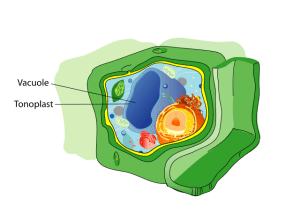Central Vacuole Definition
The central vacuole is a large vacuole found inside of plant cells. A vacuole is a sphere filled with fluid and molecules inside a cell. The central vacuole stores water and maintains turgor pressure in a plant cell. It also pushes the contents of the cell toward the cell membrane, which allows the plant cells to take in more light energy for making food through photosynthesis. Vacuoles are also found in animal, protist, fungal, and bacterial cells, but large central vacuoles are only found in plant cells.
Function of the Central Vacuole
The main function of the central vacuole is to maintain turgor pressure in the cell. Turgor pressure is the pressure of the cell’s contents pushing against the cell wall; it is only found in cells that have cell walls, such as those of plants, fungi, and bacteria. Turgor pressure changes in a cell due to osmosis, which is the diffusion of water into or out of the cell. When a plant cell is in a hypotonic solution, there is a higher concentration of water molecules outside the cell than inside, and water will flow into the cell. In plants, this causes the vacuole to be filled with water, and the cell has high turgidity. This is the optimal condition for plant cells. Isotonic solutions have roughly the same concentration of water molecules within and outside of the cell membrane, so the amount of water leaving and entering is the same. Plant cells become flaccid in isotonic solutions, and the plant may start to droop. In hypertonic solutions, where there is more water inside the cell than outside, water will flow out of the cell, and the plant will wilt and possibly die. The central vacuole is able to store a lot of water and swell up so that plant cells can maintain the high turgidity needed for the plant to function optimally. The central vacuole can also store waste products and nutrients temporarily, and the concentration of these also affects turgor pressure; having molecules other than water in the central vacuole decreases turgidity, so the cell must always have a much higher concentration of water in its central vacuole than any other molecule.
Plant cells thrive in hypotonic solutions because their cell walls keep them from bursting due to excessive water intake. By contrast, animal cells, which do not have cell walls, fare best in isotonic solutions. If animal cells are in hypotonic solutions, too much water will enter the cell and the cell can burst.
The central vacuole can take up anywhere from 30-90 percent of a plant cell’s space inside the cell membrane, and one of the central vacuole’s other functions is to push the other contents of the cell closer to the cell membrane. This allows organelles inside the plant cell called chloroplasts to receive more light, which is very important because photosynthesis occurs in chloroplasts. Photosynthesis is the production of nutrients from light energy, carbon dioxide, and water; it is how a plant makes its own food. By pushing chloroplasts closer to the surface of the cell, the central vacuole makes it possible for chloroplasts to take in more energy from sunlight.
Structure of the Central Vacuole
The central vacuole consists of two parts, the cell sap and the tonoplast. The cell sap refers to the fluid within the vacuole. It is mostly water, but also consists of ions, salts, waste products, nutrients, and sometimes pigment molecules. The tonoplast is the central vacuole’s membrane; it is also known as the vacuolar membrane. It separates the contents of the central vacuole from the rest of the cell. It is made up of phospholipids and proteins, just like the cell membrane that covers the plant cell. The proteins in the membrane of the tonoplast can control water entry and exit in the central vacuole along with regulating the movements of ions such as potassium.

This diagram of a plant cell shows the central vacuole in blue.
Related Biology Terms
- Chloroplast – The organelle in a plant cell that carries out photosynthesis.
- Vacuole – A small fluid-filled sphere of membrane in a cell that contains and transports molecules.
- Osmosis – The diffusion of water through a semi-permeable membrane.
- Tonoplast – The phospholipid membrane of the central vacuole.
Quiz
1. The cells of which organisms have a central vacuole?
A. Plants
B. Animals
C. Fungi
D. Both A and C
2. Under optimal conditions, plant cells have _____ turgor pressure.
A. High
B. Low
C. Moderate
3. Which is NOT a function of the central vacuole?
A. To store waste products
B. To control turgor pressure of the cell
C. To push other parts of a plant cell toward the surface of the cell membrane
D. To carry out photosynthesis
Central Vacuole
No comments:
Post a Comment